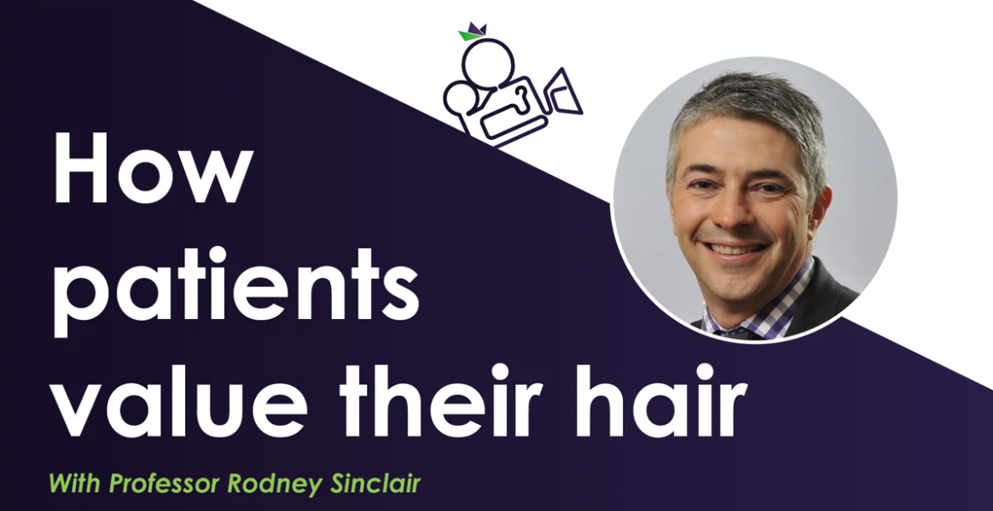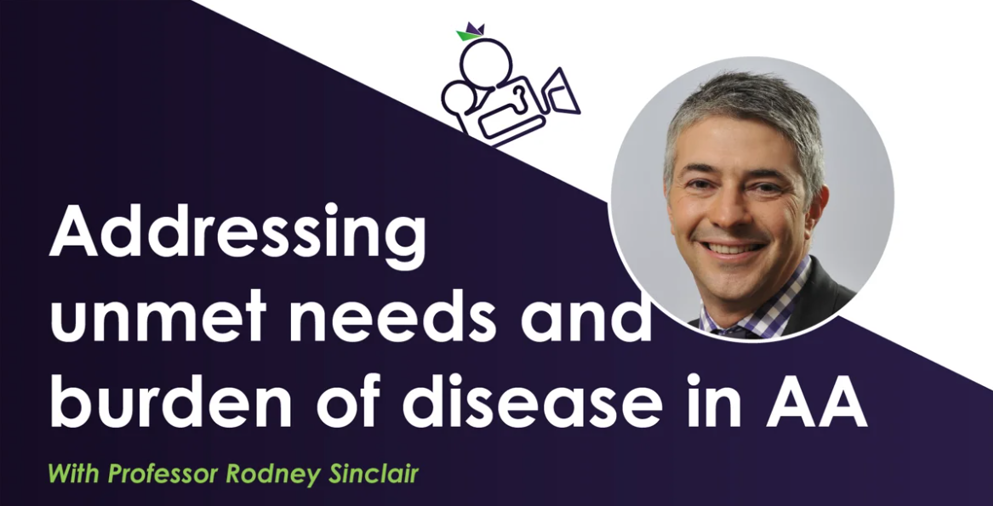
Alopecia areata
Alopecia areata epidemiology
In this short and compelling video, Lynn Wilks recounts her first signs of alopecia areata and how they affected her.
Clinical variants of alopecia areata
Alopecia areata (AA) is a common form of non-scarring hair loss, that can involve total or near-total hair loss on the scalp, or on haired bodily surfaces. The clinical variants of AA are (Figure 1):
- Patchy AA—single or multiple patches of hair loss, the most common subtype (Figure 1A)
- Alopecia totalis (AT)—total or near-total loss of scalp hair (0.08–0.15%) (Figure 1B)
- Alopecia universalis (AU)—total to near-total loss of hair on all haired surfaces of the body (0.01–0.07%)
- Alopecia areata incognita—diffuse total hair loss with positive pull test, yellow dots, short, miniaturised, regrowing hairs but no nail involvement, resembles telogen effluvium
- Ophiasis alopecia areata—band-like hair loss along the hairline (0.0–0.07%) (Figure 1C)
- Sisaipho alopecia areata—extensive alopecia except around the periphery of the scalp
- Marie Antoinette syndrome (canities subita)—diffuse alopecia with very sudden overnight greying and loss of pigmented hair
Figure 1. Clinical variants of alopecia areata. All photos used with permission by DermNet (https://dermnetnz.org/image-library). Attribution-non-commercial-noderivs 3.0 New Zealand (CC BY-NC-ND 3.0 NZ). (A) Circumscribed, “patchy” hair loss. (B) AA totalis with 100% scalp hair loss. (C) Hair loss of the occipital area (ophiasis AA). (D) Partial loss of eyebrows and eyelashes. (E) Patchy hair loss of the beard.
Alopecia areata epidemiology
AA affects people of all ages, including children and adolescents1,2. Non-white populations are disproportionately affected1.
Figure 2 illustrates the age and gender distribution in AA in the UK (Adapted2).
Figure 2. Age and gender distribution in alopecia areata in the UK (Adapted2).
Children and adolescents ≤18 years of age have an overall AA prevalence of 0.05% and commonly have a family history of AA3,4. The presence of nail splitting and discolouration indicates severe disease and a poor prognosis. For most AA patients with less severe disease, hair loss resolves spontaneously within a year5.
People of Asian origin have a threefold higher AA incidence, and people from low-income and urban areas have a higher AA incidence6.
Although the burden of AA in North American countries is declining, it is still high in southern Latin America (9.41 age-standardised disability-adjusted life-years rates [DALY]), and Australasia (9.35 DALY)6.
Possible reasons for the lower rate of AA in North America are socioeconomic status, early detection, access to dermatologists and insurance coverage, underdiagnosis (less screening for skin conditions), and disease awareness2,6.
Of people with alopecic patches persisting after one year, 30% develop AT, 15% develop AU. Prevalence rates of the more severe forms are 0.08–0.15% for AO and AT, and 0.01–0.07% for AU7-10. Overall, AA follows a variable relapsing and remitting course that is difficult to predict.
Males and females are affected equally. Male patients tend to be diagnosed at a younger median age (31 years) than female patients (36 years) and have a poorer prognosis for hair regrowth than females11. Figure 3 shows the proportion of people with AA referred for specialist dermatology review following diagnosis2.
Figure 3. Proportion of people with alopecia areata referred for specialist dermatology review within 1 year of diagnosis, by calendar year (Adapted2). Orange shading represents 95% confidence intervals.
The younger the age of onset, the greater the lifetime likelihood of severe AA (AT and AU). Severe AA often co-occurs with atopic dermatitis, eczema, asthma, vitiligo, psoriasis, lichen planus, thyroid conditions, vitamin D deficiency and anaemia11,12.
Alopecia areata pathophysiology
Professor Rodney Sinclair, (University of Melbourne) observes that “[alopecia areata] is an immunological reaction, it has a distinctive histology, and there is no convincing data to demonstrate that stress is an important trigger in alopecia areata.” Play the video to learn about alopecia areata pathophysiology.
Although the exact pathophysiology of hair loss in alopecia areata (AA) is unknown, AA is widely accepted as a complex T-cell-mediated autoimmune process, where hair follicles (HF) prematurely skip from the growing anagen phase to the resting telogen phase, resulting in hair loss13.
Damage to the HF results from an inherited susceptibility, polygenic oxidative stress, infection, or inflammation. These factors can lead to a loss of hair follicle immune privilege (HF-IP) and an autoimmune attack. A local surge of interferon (IFN)-γ activates the cytotoxic CD8+NKG2D+ T-cells, which destroy the exposed HF autoantigens13.
In figure 4, the healthy hair follicle maintains its immune privilege by suppressing MHC class I and β2 microglobulin, which stimulate natural killer (NK) cells, producing immunosuppressants, stimulating immunoinhibitory signals such as CD200; and suppressing intrafollicular antigen-presenting cell (APC), perifollicular NK cell and mast cell functions, owing to increased levels of macrophage migration inhibitory factor (MIF). Vasoactive intestinal peptide (VIP), released by perifollicular sensory nerve fibres, contributes to the immune privilege6.
In Figure 4, late anagen hair follicles in patients with AA show infiltrates of APCs, CD4+ and CD8+ T-cells, and abnormal increase in MHC class I and II molecules. CD8+ T-cells penetrate the hair follicle root sheaths6.
As AA activity subsides, the HFs progress further into the anagen phase. Proximal weakness of the hair shaft leads to the cardinal sign of “exclamation mark” hair8,13.
Figure 4. Healthy hair follicle and damaged hair follicle in alopecia areata (Adapted8). APC, antigen-presenting cell; INFγ, interferon gamma; IFNγR, interferon gamma receptor; IL2RB, IL2 receptor subunit beta; IL15RA, IL15 receptor subunit alpha; JAK, Janus kinase; MMF, macrophage migration inhibitory factor; NKG2D, NK cell receptor D; NKG2DL, NKG2D ligand; P, phosphorylated; POMC, pro-opiomelanocortin; STAT1, signal transducer and activator of transcription 1; TCR, T-cell receptor; TGFB, transforming growth factor beta, VIPR, VIP receptor.
Genetic predisposition in alopecia areata
AA is more likely to have a hereditary predisposition; according to estimates, 10–20% of patients with AA have favourable family histories, compared to 1.7% of control participants. A high concordance in monozygotic twins (45–55%) has been reported. Genetic susceptibility to AA has been identified in 14 gene loci in the HLA class I region that signal for HF maturation. In addition to autoimmunity, AA patients are susceptible to abnormal keratinisation of the hair shaft14-16.
Functional genetic studies and genome-wide association studies show that CD8+NKG2D+T-cells are the major effectors of AA disease pathogenesis. These cells depend on IL-15 signalling for their survival, providing an opportunity to investigate a new approach to therapy with Janus kinase (JAK) inhibitors, which target the downstream effects of the janus kinase signal transducer and activator of transcription (JAK/STAT) pathway)8.
Polygenic susceptibility is responsible for AA initiation and variation in clinical subtypes8,17.
Environmental triggers of alopecia areata
Mental and physical stress, vaccinations, febrile illnesses, and drugs are often linked with the onset of AA symptoms. Viruses such as Epstein Barr virus (EBV), hepatitis B and C viruses, the swine flu virus, and the SARS Cov-2 virus, have been implicated in the autoimmune reaction of AA8,18-20.
Mediators induced by mental stress, such as corticotropin-releasing hormone (CRH), substance P and nerve growth factor, act through the hypothalamic-pituitary axis. Prolonged stress causes a cytokine imbalance by activating the tumour necrosis factor-alpha (TNFα), interferon-gamma (IFNγ), and the T-helper cell Type 1 (TH1), damaging epithelial and mesenchymal cells, and stopping hair growth7,21,22.
Collapse of immune privilege in alopecia areata
Healthy HFs are immune to attack as they have no lymphatics, the extracellular matrix is copious, antigens are separated, and natural killer (NK) cells are suppressed. These barriers are combined with the downregulation of major histocompatibility complex (MHC) class I and II molecules to maintain hair follicle immune privilege (HF-IP). Overexpression of macrophage migration inhibitory factor (MIF), an NK cell inhibitor, prevents a type of T lymphocytes (CD56+/NKG2D+ NK cells) from invading the HF23.
Macrophages in the HF root sheath cells that express IFNγ stay repressed under the influence of immune guardians, such as transforming growth factor (TGF)-β, αmelanocyte-stimulating hormone (α-MSH), IL-10, macrophage migration inhibitory factor (MIF) and somatostatin (Figure 5)8.
Figure 5. The hair cycle in alopecia areata (Adapted8).
Environmental triggers cause abnormal MHC class I and II expression, leading to inflammatory cell infiltrates. The cytotoxic CD56+/NKG2D+ NK cells start hypersecreting IFNγ to initiate a collapse of the HF-IP19,24.
HF autoantigens responsible for AA autoimmunity (tyrosinase-related protein, gp100, trichohyalin, melanoma antigen, and retinol-binding protein are immune-recognised after the collapse of HF-IP. Lastly, the vasoactive intestinal peptide receptors (VIPR1 and VIPR2) in the HF epithelium are downregulated with defective signalling in the hair bulbs of patients with AA8,7,21,22.
A dense perifollicular inflammatory cell infiltration, known as a “swarm of bees,” and damaged HFs are observed in the acute phase of AA (Figure 6). In the chronic phase of AA, the cell infiltration subsides, and a prolonged telogen phase can be observed (Figure 6)7.
Figure 6. Histopathology in acute and chronic alopecia areata (Adapted7). Acute alopecia areata is marked by a dense perifollicular inflammatory infiltrate and damaged hair follicles. In the chronic phase, inflammatory cell infiltrate decreases, and the catagen or telogen phase is prolonged.
Interferon-γ (IFNγ) and the janus kinase signal transducer and activation of transcription (JAK/STAT) pathway
A JAK/STAT-dependent type 1 cytokine loop can lead to the prolongation of AA and chronic disease24,25
IFNγ as mediator of type 1 cytokines in alopecia areata
The primary mediator of type 1 cytokines in AA is IFNγ. When IFNγ binds to receptors in the HF epithelium, C-X-C Motif Chemokine Receptor 3 (CXCR3) and its ligands CXCL9, CXCL10, and CXCL11, MHC class I, and MICA are induced via the JAK/STAT pathway (Figure 7).
Figure 7. Initial autoimmune mechanisms in alopecia areata (Adapted24). AA, alopecia areata; CXCL, chemokine (C-X-C motif) ligand; CXCR3, C-X-C Motif Chemokine Receptor 3; GZMB, granzyme B; IFN, interferon, IL, interleukin; JAK, Janus kinase; MHC, major histocompatibility complex; MICA, major histocompatibility complex class I chain-related gene A; NK, natural killer; PDCs, plasmacytoid dendritic cells; Treg cells, regulatory T-cells; STAT, signal transducer and activator of transcription; Th cells, T-helper cells; TNF, tumour necrosis factor; ULBP, UL16-binding protein.
This JAK/STAT-dependent type 1 cytokine loop leads to the prolongation of AA and chronic disease24,25.
Role of type 2 cytokines in alopecia areata
Although predominantly a type 1 inflammation, scalp lesions in AA also show type 2-related biomarkers, such as IL-4, IL-13, CCL18, and thymic stromal lymphopoietin (TSLP), and raised levels of IL-4, IL-5, IL-6, CCL17, IgE, and eosinophilia in the serum24,25. A third axis of pro-inflammatory T Helper-17 (Th17) related cytokines IL-17 and IL-22 is responsible in the more severe and refractory forms of AA26,27.
Future research on pathogenesis in alopecia areata
Vascular changes in alopecia areata
Vascular changes, such as decreased angiogenesis in lesions, play a role in the pathogenesis of AA28. The role of the microbiota in the pathogenesis of various diseases, including AA, is an emerging area of research29.
Changes in serum levels in alopecia areata
Serum levels of cardiovascular biomarkers such as cardiac troponin I and N-terminal pro-B type natriuretic peptide (NT-proBNP) are elevated in AA, but their significance is unknown. Serum adiponectin levels are inversely correlated with disease severity in AA, which aligns with AA patients at higher risk of developing lifestyle diseases such as obesity, hyperlipidaemia, diabetes mellitus, or metabolic syndrome8.
Alopecia areata burden
Lynn Wilks, a patient with alopecia areata (AA), recounts that “At the end of 2020, I lost my eyebrows and eyelashes. That really knocked my confidence. You feel that you’ve lost all definition. My face didn’t look like my face anymore.” Learn about the burden of alopecia areata (AA) on patients in the videos below.
Burden of alopecia areata
Patient burden and unmet needs in treatment and management with Dr Brett King.
Disability-adjusted life years
Disease burden evaluates the impact of living with illness, injury, and premature death. It is commonly evaluated by disability-adjusted life years (DALY), which combine years lost to disability (morbidity) and years lost to death (mortality). Globally, the mean DALY in AA were ~19.4 years across 21 geographic regions, and remained unchanged from 1990–20102,3,30,31. From 1990–2019, the largest increases in the age-standardised DALY rate were in low socio-demographic index quintile and Western Sub-Saharan Africa regions32.
Quality of life
Over half of patients with AA are burdened with poor health-related quality of life (HRQoL). Risk factors for low HRQoL are age between 20–50 years, female sex, lightening of skin colour, hair loss greater than 25%, family stress, and job change. Patients with extensive AA report more adverse psychological consequences than those with less severe AA3.
AA ranks higher in disrupting patient HRQoL than melanoma, non-melanoma skin cancer, and psoriasis4,30,33.
Psychosocial stresses due to AA in adults, children and their caregivers lead to a poor HRQoL proportionate to the extent of scalp involvement (Figure 8)30.
Figure 8. Quality of life in people with alopecia areata (Adapted30). Short-Form (SF)-36 scores: 0 = poorest health-related quality of life; 100 = highest health-related quality of life. SF-36 domains explained in this figure: Role physical (limitations in usual role activities because of physical health problems); Physical functioning (limitations in physical activities because of health problems); Social functioning (limitations in social activities because of physical or emotional problems); Role emotional (limitations in usual role activities because of emotional problems); Mental health (psychological distress and well-being); Vitality (energy and fatigue). Ghajarzadeh et al. 201234; Jankovic et al. 201535; Gulec et al. 200436; Masmoudi et al. 201337; de Hollanda et al. 201438; Dubois et al. 201039.
Psychiatric comorbidity
Lynn Wilks describes the adverse impact of AA on her perceived self-identity, and the close relationship between a person’s physical appearance and self-image. Watch below.
A 66%–74% lifetime prevalence of psychiatric disorders has been reported in AA patients, with a 39%–62% prevalence of anxiety, and a 38%–39% lifetime prevalence of depression3.
There is an increased risk of depression in patients with AA aged <20 years, and an increased risk of anxiety in those aged 40–59 years3
Hair loss can negatively affect body image, leading to sleep problems and sometimes adolescent suicides40. Nearly a third of patients lose their existing partners because of the other person’s inability to cope with their changed appearance41.
Some treating physicians consider AA medically benign, due to the self-limited hair loss in most patients. Physicians commonly use reassurance and ‘wait and watch’ for three months, regarding treatment as unnecessary. The absence of effective therapies can add to patient feelings of hopelessness and persistent anxiety about worsening hair loss in the future8,30.
Comorbid medical conditions
Comorbid medical conditions can adversely impact on disability levels, patient quality of life, and psychiatric comorbidity. Clinicians caring for patients diagnosed with AA should consider assessing for comorbid conditions, including3:
- Patients with a family history of vitiligo are more likely to develop extensive or severe AA
- Atopic dermatitis was reported in 15.6% of adults with AA, and in 39.5% of children with the condition
- Prevalence of thyroid peroxidase antibodies in AA patients has been reported to be 17.7%, approximately double that of the general population, with a female-to-male predominance of 6.7:1
References
- Lintzeri DA CA, Hillmann K, Ghoreschi K, Vogt A, Blume-Peytavi U. Alopecia areata - Current understanding and management. J Dtsch Dermatol Ges. 2002;20(1):59–90.
- Harries M, Macbeth AE, Holmes S, et al. The epidemiology of alopecia areata: a population-based cohort study in UK primary care. Br J Dermatol. 2022;186(2):257–265.
- Villasante Fricke AC, Miteva M. Epidemiology and burden of alopecia areata: a systematic review. Clin Cosmet Investig Dermatol. 2015;8:397–403.
- Dainichi T, Kabashima K. Alopecia areata: What's new in epidemiology, pathogenesis, diagnosis, and therapeutic options? J Dermatol Sci. 2017;86(1):3–12.
- Olsen EA, Roberts J, Sperling L, et al. Objective outcome measures: Collecting meaningful data on alopecia areata. J Am Acad Dermatol. 2018;79(3):470–478 e3.
- Wang H, Pan L, Wu Y. Epidemiological Trends in Alopecia Areata at the Global, Regional, and National Levels. Front Immunol. 2022;13:874677.
- Fukuyama M, Ito T, Ohyama M. Alopecia areata: Current understanding of the pathophysiology and update on therapeutic approaches, featuring the Japanese Dermatological Association guidelines. J Dermatol. 2022;49(1):19–36.
- Pratt CH, King LE, Jr., Messenger AG, Christiano AM, Sundberg JP. Alopecia areata. Nat Rev Dis Prim. 2017;3:17011.
- Vu BK, Tuson H, Harricharan S, et al. EPH57 Epidemiology of Alopecia Areata Across Global Regions – A Systematic Literature Review. Value Health. 2022;25(12).
- Lee HH, Gwillim E, Patel KR, et al. Epidemiology of alopecia areata, ophiasis, totalis, and universalis: A systematic review and meta-analysis. J Am Acad Dermatol. 2020;82(3):675–682.
- Mirzoyev SA, Schrum AG, Davis MDP, Torgerson RR. Lifetime incidence risk of alopecia areata estimated at 2.1% by Rochester Epidemiology Project, 1990–2009. J Invest Dermatol. 2014;134(4):1141-1142.
- Zhang T, Nie Y. Prediction of the Risk of Alopecia Areata Progressing to Alopecia Totalis and Alopecia Universalis: Biomarker Development with Bioinformatics Analysis and Machine Learning. Dermatol. 2022;238(2):386–396.
- Simakou T, Butcher JP, Reid S, Henriquez FL. Alopecia areata: A multifactorial autoimmune condition. J Autoimmun. 2019;98:74–85.
- Jackow C, Puffer N, Hordinsky M, Nelson J, Tarrand J, Duvic M. Alopecia areata and cytomegalovirus infection in twins: genes versus environment? J Am Acad Dermatol. 1998;38(3):418–25.
- Rodriguez TA, Fernandes KE, Dresser KL, Duvic M. Concordance rate of alopecia areata in identical twins supports both genetic and environmental factors. J Am Acad Dermatol. 2010;62(3):525–7.
- Betz RC, Petukhova L, Ripke S, et al. Genome-wide meta-analysis in alopecia areata resolves HLA associations and reveals two new susceptibility loci. Nat Comm. 2015;6(1):5966.
- Oka A, Takagi A, Komiyama E, et al. Alopecia areata susceptibility variant in MHC region impacts expressions of genes contributing to hair keratinization and is involved in hair loss. EBioMed. 2020;57:102810.
- Gilhar A, Etzioni A, Paus R. Alopecia areata. N Engl J Med. 2012;366(16):1515–25.
- Mcelwee KJ, Gilhar A, Tobin DJ. What causes alopecia areata? Exper Dermatol. 2013;22(9):609–626.
- Christensen RE, Jafferany M. Association between alopecia areata and COVID-19: A systematic review. JAAD Internat. 2022;7:57–61.
- Peters EMJ, Liotiri S, Bodó E. Probing the Effects of Stress Mediators on the Human Hair Follicle: Substance P Holds Central Position. Am J Pathol. 2007;171(6):1872–1886.
- Tzur Bitan D, Berzin D, Kridin K, Cohen A. The association between alopecia areata and anxiety, depression, schizophrenia, and bipolar disorder: a population-based study. Arch Dermatol Res. 2022;314(5):463–468.
- Ito T, Ito N, Saatoff M. Maintenance of hair follicle immune privilege is linked to prevention of NK cell attack. J Invest Dermatol. 2008;128(5):1196–206.
- Suchonwanit P, Kositkuljorn C, Pomsoong C. Alopecia Areata: An Autoimmune Disease of Multiple Players. Immunotargets Ther. 2021;10:299–312.
- Lensing M, Jabbari A. An overview of JAK/STAT pathways and JAK inhibition in alopecia areata. Front Immunol. 2022;13:955035.
- Dai Z, Chen J, Chang Y, Christiano AM. Selective inhibition of JAK3 signaling is sufficient to reverse alopecia areata. JCI Insight. 2021;6(7).
- Crowley EL, Fine SC, Katipunan KK, Gooderham MJ. The Use of Janus Kinase Inhibitors in Alopecia Areata: A Review of the Literature. J Cutan Med Surg. 2019;23(3):289–297.
- Peterle L, Sanfilippo S, Borgia F, Cicero N, Gangemi S. Alopecia Areata: A Review of the Role of Oxidative Stress, Possible Biomarkers, and Potential Novel Therapeutic Approaches. Antiox. 2023;12(1):135.
- Paus R. The Evolving Pathogenesis of Alopecia Areata: Major Open Questions. J Investig Dermatol Sympos Proceed. 2020;20(1):S6–S10.
- Liu LY, King BA, Craiglow BG. Health-related quality of life (HRQoL) among patients with alopecia areata (AA): A systematic review. J Am Acad Dermatol. 2016;75(4):806–812 e3.
- Karimkhani C, Boyers LN, Naghavi M. The global burden of disease associated with alopecia areata. Brit J Dermatol. 2015;172(5):1424–1426.
- Wang H, Pan L, Wu Y. Epidemiological trends in alopecia Areata at the global, regional, and National Levels. Front Immunol. 2022;13.
- Korta DZ, Christiano AM, Bergfeld W. Alopecia areata is a medical disease. J Am Acad Dermatol. 2018;78(4):832–834.
- Ghajarzadeh M, Ghiasi M, Kheirkhah S. Associations between skin diseases and quality of life: a comparison of psoriasis, vitiligo, and alopecia areata. Acta Med Iran. 2012;50:511–515.
- Jankovic S, Peric J, Maksimovic N. Quality of life in patients with alopecia areata: a hospital-based cross-sectional study. J Eur Acad Dermatol Venereol. 2015;30(5):840–846.
- Gulec AT, Tanriverdi N, Duru C, Saray Y, Akcali C. The role of psychological factors in alopecia areata and the impact of the disease on the quality of life. Int J Dermatol. 2004;43:352–356.
- Masmoudi J, Sellami R, Ouali U. Quality of life in alopecia areata: a sample of Tunisian patients. Dermatol Res Pract. 2013; 2013:983804.
- de Hollanda TR, Sodre CT, Brasil MA, Ramos ESM. Quality of life in alopecia areata: a case-control study. Int J Trichol. 2014;6:8–12.
- Dubois M, Baumstarck-Barrau K, Gaudy-Marqueste C, Richard MA, Loundou A, Auquier P, et al. Quality of life in alopecia areata: a study of 60 cases. J Invest Dermatol. 2010;130:2830–2833.
- Marahatta S, Agrawal S, Adhikari BR. Psychological Impact of Alopecia Areata. Dermatol Res. Pract. 2020;2020:1–5.
- Sinclair RD. Alopecia areata and suicide of children. Med J Austr. 2014;200(3):145–145.
of interest
are looking at
saved
next event
Developed by EPG Health. This content has been developed independently of the sponsor, Pfizer, who has reviewed the content only for scientific accuracy. EPG Health received funding from the sponsor in order to help provide healthcare professionals with access to the highest quality medical and scientific information, education and associated relevant content.






